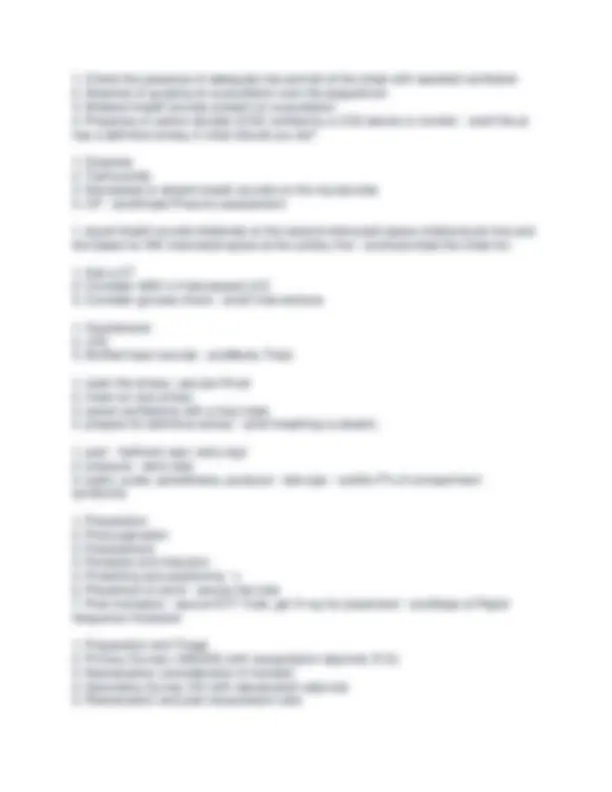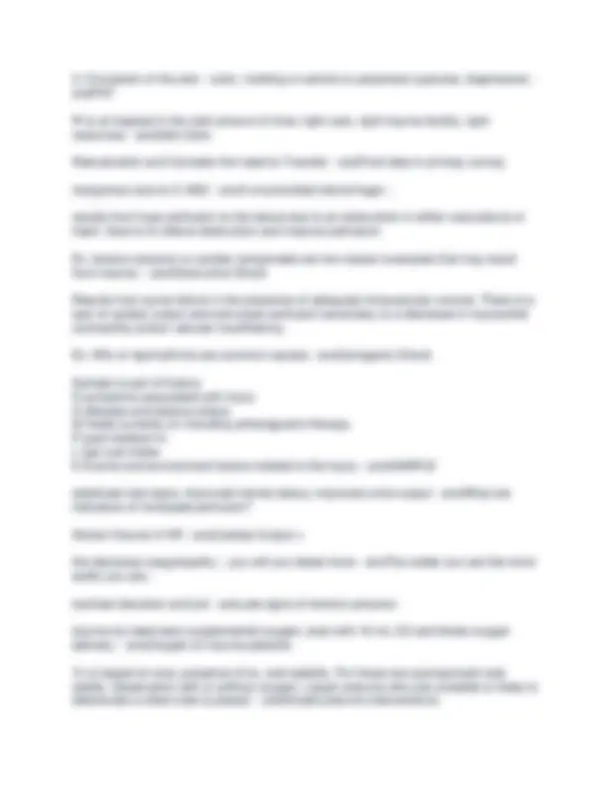











Study with the several resources on Docsity

Earn points by helping other students or get them with a premium plan


Prepare for your exams
Study with the several resources on Docsity

Earn points to download
Earn points by helping other students or get them with a premium plan
Community
Ask the community for help and clear up your study doubts
Discover the best universities in your country according to Docsity users
Free resources
Download our free guides on studying techniques, anxiety management strategies, and thesis advice from Docsity tutors
TNCC Written Exam 2025 Flashcards.pdf
Typology: Exams
1 / 15

This page cannot be seen from the preview
Don't miss anything!










Affect concentration, memory, sleep, mode, and libido. Causes headaches, dizziness and nausea. - ansPostconcussive Syndrome/ Mild Traumatic Brain Injury An rise in diastolic blood pressures is a sign of increasing what? - ansPeripheral resistance Anxiety, confusion, restlessness, narrowing pulse pressure, tachycardia, bounding pulse, and decreasing urinary output are signs of what? - ansCompensated Shock Becks Triad is a sign of what? And includes what three symptoms? - ansCardiac Tamponade;
Does hypoventilation cause dilation or constriction? Increase or decrease ICP? - ansDilation and increase in ICP due to high CO Dysrhythmia, ischemic changes, and persistent unexplained tachycardia are signs of what? - ansMyocardial contusion from Blunt Cardiac Injury Efficient production of ATP, which maintains cellular metabolic function, is seen with what type of metabolism? - ansAerobic metabolism Epidural hematoma is caused by an arterial or venous bleed? Sx are transient LOC followed by a lucid period. - ansArterial Extremity elevation AT the level of the heart is beneficial for what type of injury? - ansCompartment Syndrome Fluid replacement goals/calculation - ans2mL/kg LR x TBSA% (give 1/2 over first 8 hours (minus transport time) and 1/2 over next 16 hours) Glasgow Coma Score with Mild, Moderate, and Severe TBI - ansMild = 13- 15 Moderate = 9- 12 Severe = 3- 8 Goal value for Cerebral Perfusion Pressure (CPP) - ans> Goal value for ICP - ans< Greatest risk to the patient during interfaculty transfer/transport? - ansLoss of airway and respiratory compromise Hear bowel sounds in chest and Kehr's sign seen with what? - ansTraumatic Diaphragmatic Tear Hemoptysis, ineffective cough, crackles in affected lung, hypoxia/hypercapnia, and alveolar opacities are signs of what? - ansPulmonary Contusion Hyperventilation cause dilation or constriction? - ansConstriction d/t low CO Hyperventilation causes cerebral blood vessels to do what? - ansConstrict Incision with blood clot, edges approximated with suture closer, and results in a fine scar. This is __________ Intention. - ansPrimary Inefficient production of ATP, byproduct is lactic acid, leads to metabolic acidosis, cellular dysfunction leads to cell death with what type of metabolism? - ansAnaerobic metabolism
Reservoir depletion and hemorrhage cause which type of shock? - ansHypovolemic Shock Signs and symptoms similar to early signs of increased ICP but do not worsen. - ansPostconcussive Syndrome/ Mild Traumatic Brain Injury Signs of what include anxiety, pleuritic chest pain, dyspnea, hypoxemia, hemoptysis, cough, orthopnea, adventitious lung sounds, decreased lung sounds, jugular vein distention, or hypotension? - ansPulmonary Embolus Signs of what include asymmetric pupillary reactivity, unilateral dilation, widening pulse pressure, abnormal motor posturing, bradycardia, and decreased respiratory effort? - ansLate signs of increased ICP with Herniation Syndrome Signs of what include headache, nausea and vomiting, amnesia, behavioral changes, altered level of consciousness? - ansIncreased intracranial pressure Signs of what include muscle pain or weakness, dark red or brown urine, general weakness or malaise, and elevated creatinine kinase levels? - ansRhabdomyolosis Sluggish reaction of pupils is an early sign of what? - ansIncreasing ICP Soft, dry, red wound with intact skin that blanches with pressure. No blistering or sloughing. What degree burn? - ansFirst degree; superficial Spinal cord injuries at C3-C5 causes loss of what nerves function, resulting in what? - ansPhrenic nerve; paralyzed diaphragm and inability to breath Stages of shock - ans1. Compensatory Shock 2. Decompensatory Shock (progressive, hypotensive) 3. Irreversible Shock Subdural hematoma is caused by tearing of the ______ veins and symptoms usually present within ____ hours of the accident. - ansBridging; 72 Tachycarida, weak pulses, hypotension, cool periphery, delayed cap refill, anxiety and agitation are signs of what type of shock? Seen with what? - ansObstructive Shock; Cardiac Tamponade Tearing chest/back pain, unequal blood pressure and pulses are a sign of what? Caused by a high mechanism of injury. - ansThoracic Aortic Disruption Tertiary care facility, teaching hospital, comprehensive care from resuscitation or rehabilitation, research, injury prevention. - ansLevel 1 Trauma Center
The cellular process in which glucose is metabolized into energy without oxygen. Energy is produced in an inefficient manner with many waste products. - ansAnaerobic metabolism The cellular process in which oxygen is used to metabolize glucose. Energy is produced in an efficient manner with minimal waste products. - ansAerobic metabolism Trauma rescucitation and definitive trauma care. Specialty and rehabilitation care may not be as comprehensive, may not conduct research. - ansLevel 2 Trauma Center Treatment for cariogenic shock - ansinotropic support, anti-dysrhythmic medications, treat myocardial infarction or other underlying cause Treatment for distributive shock - ansSupport ventilations, vasopressors, pain management, apply warming methods Treatment for hypovolemic shock - ansTourniquet, 1:1:1 blood products, massive transfusion protocol, TXA, surgical repair Treatment for obstructive shock - anspericardiocentesis, cardiac window, needle decompression, position pregnant patient on L side Triage colors and meanings: - ansGreen - minor, walking wounded Yellow - delayed Red - immediate Black - expectant, deceased Urine Output goals for fluid replacement therapy - ans0.5 mL/kg (30-50mL/hr) Vasodilation, anaphylaxis, sepsis, and spinal cord injuries cause which type of shock? - ansDistributive Shock Waxy white to leathery gray to charred skin that is dry and firm with absent hair, no blanching. What degree burn? - ansThird degree; full thickness Wet, waxy, red to pale skin that does not blanch, multiple sisters. What degree burn? - ansSecond degree; deep partial thickness What decrease ICP by decreasing cellular edema? - ansOsmotic diuretics (such as 3% saline and mannitol) What is a high risk of frostbite? - ansThrombus formation What is caused by the tear of the bridging veins or middle meningeal artery? - ansSubdural and Epidural Hematoma
Which phase of a blast results from flying debris, projectiles, and bomb fragments causing lacerations or penetrating injuries? - ansSecondary Phase Will hypocapnia cause vasoconstriction or vasodilation, especially in the cerebral vasculature? - ansVasoconstriction Zones of burn injury (3) - ansZone of coagulation Zone of stasis Zone of hyperemia
Aortic Dissection - ansUnequal extremity pulse strength possibility of.. apply direct pressure to bleeding elevate extremity apply pressure over arterial sites Consider a pelvic binder for pelvic fractures consider a tourniquet cannulate two veins with large caliber IV - if unable to gain assess consider IO a. obtain labs, type and cross b. infuse warm isotonic fluids c. consider balanced resuscitation d. use rapid infusion device - ansC Interventions: ask pt to pen his or her mouth - ansWhile assessing airway the patient is alert and responds to verbal stimuli you should.. Before the arrival of the pt - ansWhen should PPE be placed: brachial pulse - ansUnder age of 1 where do you find a pulse Breathing: To assess breathing expose the chest:
Capnography monitors numeric value, as well as continuous waveform, indicating real- time measurement and trending over time. - ansQuantitative: Caused by blood in the intrapleural space/ May also occur from lac to live or spleen combined with injury to the diaphragm. Ensure two large bore IVS are placed. Prepare for thoracentesis and chest tube insertion. If open thoracotomy is done chest tube is deferred. - ansHemothorax: Circulation and Control of Hemorrhage Inspect first for any uncontrolled bleeding Skin color palpate for central pulses - carotid and femoral - rate, rhythm, and strength Skin temp: cool, diaphoretic, or warm and dry - ansC Colorimetric CO2 detectors provide info about the presence or absence of CO2. A chemically treated indicator strip changes color revealing the presence or absence of exhaled CO2 - ansQualitative D displaced tube O obstructed or kinked P pneumothorax E equipment failure , such as becoming detached from the equipment or loss of capnopgrahy - ansDOPE Disability - Neurologic Status
inspect posterior surfaces blogroll with at least 3 people. maintain c spine take out backboard Rectal tone per MD - ansI inspect, auscultate, palpate any spontaneous breathing, rate, depth, and degree of effort, use of accessory muscles lacs, contusions, auscilate lung sounds and heart sounds - ansHead to toe assessment: Chest jaw thrust maneuver to open airway and assess for obstruction. If pt has a suspected csi, the jaw thrust procedure should be done by two providers. One provider can maintain c-spine and the other can perform the jaw thrust maneuver. - ansWhile assessing airway pt is unable to open mouth, responds only to pain, or is unresponsive you should.. labs, wound care, tetanus, administer meds, prepare for transfer - ansSecondary Reval Adjuncts Needle pericardiocentesis, but it is a temp solution. Requires surgical evaluation. (Ultrasound guided) - ansCardiac Tamponade Intervention: occurs as a result of maldistribution of an adequate circulating blood volume with the loss of vascular tone or increased permeability. Ex: Anaphylactic - release of antihistamines Septic Shock - systemic release of bacterial endotoxins, resulting in increased vascular permeability and vasodilation. Neurogenic shock - spinal cord injury results of loss in sympathetic nervous system control of vascular tone. Goal: Volume replacement and vasoconstriction - ansDistributive Shock Pediatric Assessment Triangle